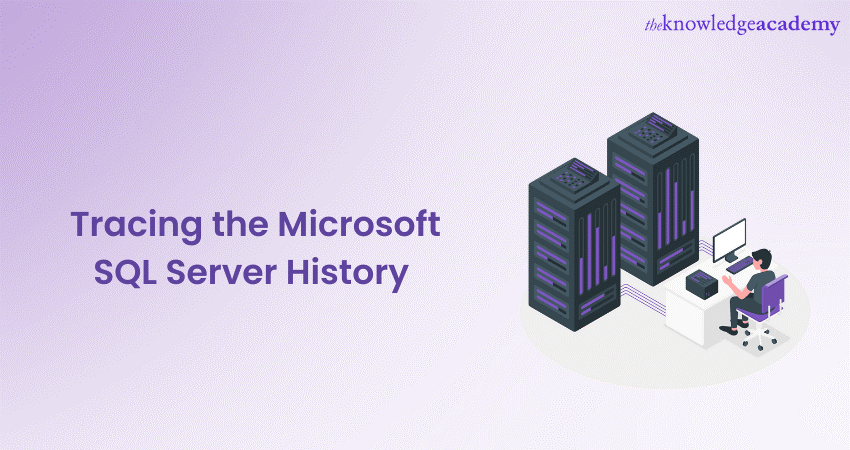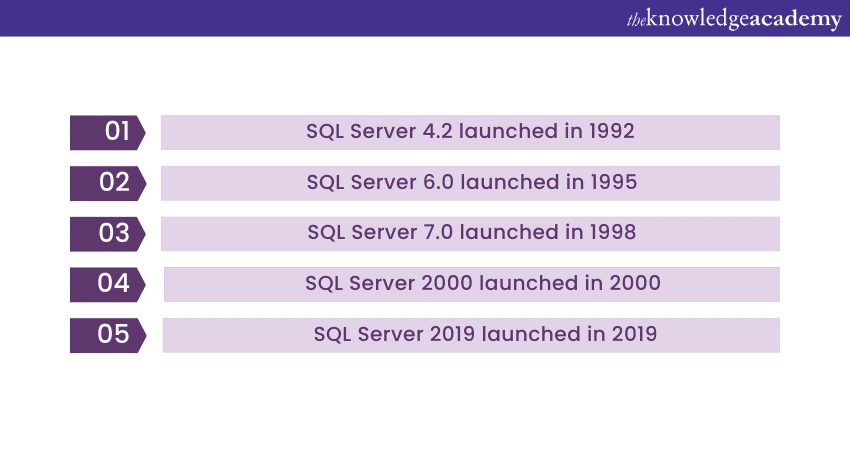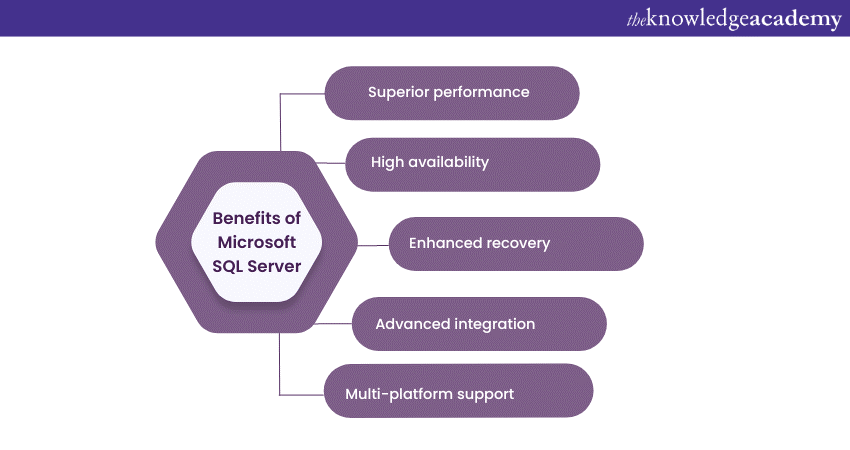We may not have the course you’re looking for. If you enquire or give us a call on +30 2111995372 and speak to our training experts, we may still be able to help with your training requirements.
We ensure quality, budget-alignment, and timely delivery by our expert instructors.

Microsoft SQL Server is one of the pioneers in database management systems. Since its inception, it has evolved significantly. With each passing year, it introduced innovative features to adapt to the constantly varying demands of the industry. Learning about Microsoft SQL Server History can help us understand these changes' significance and what challenges they overcome.
According to DB-Engines, Microsoft SQL Server is the third most popular database management system. It was launched in 1989, nearly 34 years ago, and a lot has changed in these years. In this blog, you will learn Microsoft SQL Server History, characteristics, and various versions.
Table of Contents
1) History of Microsoft SQL Server
a) Initial collaboration
b) SQL Server 1.0: The First Commercial Release
2) Various versions of Microsoft SQL Server
3) Characteristics of Microsoft SQL Server
4) Conclusion
History of Microsoft SQL Server
In the early days of its launch, the Microsoft SQL Server achieved several significant milestones and developments in the database management domain. Let's delve into the key aspects and features of this initial phase.

Initial collaboration
In the early 1980s, Microsoft partnered with Sybase and Ashton-Tate to develop a new database management system. This collaboration laid the foundation for the birth of Microsoft SQL Server.
SQL Server 1.0: The first commercial release
Microsoft released SQL Server 1.0 as its first commercially available version in 1989. This marked the official entry of Microsoft into the database management market.
Client-Server architecture
SQL Server 1.0 introduced support for client-server architecture, enabling multiple clients to connect to a central server to access and manipulate data. This architecture revolutionised data management and access.
Advanced transaction processing
The initial version of SQL Server showcased advanced transaction processing capabilities, allowing users to perform complex and secure data transactions. This capability was crucial for maintaining data integrity.
Sybase SQL Server: The Foundation
The early versions of SQL Server were based on the codebase of Sybase SQL Server. Microsoft worked closely with Sybase and gradually developed its own distinct versions of SQL Server.
SQL Server 4.2 and beyond
Following the initial release, Microsoft continued to evolve SQL Server with subsequent versions. SQL Server 4.2, released in 1992, introduced significant performance enhancements and improved functionality.
SQL Server 6.0: A major milestone
SQL Server 6.0 was released in 1995 and was a major milestone for the platform. It brought significant improvements in performance, scalability, and data integrity, setting the stage for SQL Server's widespread adoption. These early developments, collaborations, and subsequent versions of SQL Server set the stage for rapid evolution and growth in the years to come.
Evolution of Microsoft SQL Server
The evolution of Microsoft SQL Server has been marked by significant advancements and collaborations, many of which are documented in comprehensive Microsoft SQL Server Books that detail its development. Let's explore the key aspects of its evolution:
a) Continuous enhancements: Microsoft SQL Server has undergone continuous enhancements and introduced new features to meet the changing needs of businesses and developers.
b) Business intelligence: SQL Server integrated powerful business intelligence capabilities, enabling advanced data analytics, reporting, and data mining for informed decision-making.
Join our Introduction to MySQL course to learn the various database concepts and to effectively managing the data. Sign up today!
Various versions of Microsoft SQL Server
Microsoft SQL Server has seen several major versions throughout its history, each introducing significant features, enhancements, and improvements. Let's explore some of the notable versions:

SQL Server 7.0
Released in 1998, SQL Server 7.0 was a significant milestone. It introduced several groundbreaking features, such as support for online indexing operations, data transformation services, and the ability to create data-driven websites with Active Server Pages (ASP).
SQL Server 2000
SQL Server 2000 brought enhanced scalability, reliability, and business intelligence capabilities. It introduced features like Analysis Services for data analysis, Data Transformation Services (DTS) for data integration, and XML support.
SQL Server 2005
Released in 2005, SQL Server 2005 marked a major leap forward. It brought in a wide range of new features, including native support for XML and improved programmability with the introduction of Common Language Runtime (CLR) integration.
SQL Server 2008
Released in 2008, the SQL Server 2008 introduced significant performance, security, and business intelligence upgrades. It introduced Transparent Data Encryption (TDE) features, auditing, and policy-based management.
SQL Server 2012
Released in 2012, the SQL Server 2012 brought significant advancements in availability, reporting, and business intelligence. It introduced AlwaysOn Availability Groups for high availability, improved Reporting Services, and enhanced Power View for data visualisation.
SQL Server 2014
Released in 2014, SQL Server 2014 focused on performance, scalability, and hybrid cloud capabilities. It introduced the In-Memory OLTP engine, enhanced AlwaysOn Availability Groups, and improved integration with Microsoft Azure.
SQL Server 2016
This introduced revolutionary features such as Query Store for performance monitoring and tuning, Stretch Database for seamless data archiving to the cloud, and support for JSON data.
SQL Server 2017
It introduced cross-platform support for Linux, enabling users to deploy SQL Server on various operating systems. It also brought enhancements to graph data processing and Machine Learning Services.
SQL Server 2019
Released in 2019, it focused on big data integration and AI capabilities. It introduced features like Big Data Clusters, enabling users to deploy SQL Server with Apache Spark and Hadoop Distributed File System (HDFS) integration.
Each major version of Microsoft SQL Server has brought new features, improvements, and innovations, making it a versatile and powerful database management system that caters to the evolving needs of businesses and developers.
Enhance your SQL skills with comprehensive training with our comprehensive Introduction To SQL Training – Signup now!
Characteristics of Microsoft SQL Server
Microsoft SQL Server offers the perfect combination of performance, security, scalability, and integration, making it the preferred choice for businesses of all sizes. Here's a list of its key features:

a) RDBMS: SQL Server is a robust Relational Database Management System that ensures data integrity and supports efficient data retrieval and storage.
b) Scalability and Performance: SQL Server scales effortlessly to handle large data processing with features like partitioning and optimisation for improved performance.
c) Security Features: SQL Server prioritises data security with authentication, access controls, encryption, auditing, and row-level security.
d) Business Intelligence: SQL Server integrates comprehensive business intelligence tools for analysis, reporting, and data integration.
e) Availability and Disaster Recovery: SQL Server provides high availability features like AlwaysOn Availability Groups and disaster recovery options for quick data recovery.
f) Integration with Microsoft Ecosystem: SQL Server seamlessly integrates with Azure, Power BI, Visual Studio, and Windows Server.
g) Extensibility and Integration: SQL Server supports extensibility through CLR integration and offers integration with external systems.
h) Cross-Platform Support: SQL Server extends its compatibility to Linux, providing flexibility in deployment options.
These characteristics define SQL Server as a reliable and feature-rich database management system for diverse applications.
Learn advanced concepts and techniques on SQL with our Advanced SQL Training - Signup today!
Conclusion
We hope you read and understand everything about the Microsoft SQL Server History. In this blog, we discussed its versions introduced over the years and the key characteristics of Microsoft SQL Server. It is an amazing platform with many benefits. Learning about its history will provide a different perspective on the platform.
Gain the most valuable and in-demand SQL skills with our SQL Training courses - Signup now!
Upcoming Microsoft Technical Resources Batches & Dates
Date
 Microsoft Excel Course
Microsoft Excel Course
Mon 10th Mar 2025
Mon 7th Apr 2025
Mon 9th Jun 2025
Mon 8th Sep 2025
Mon 1st Dec 2025






 Top Rated Course
Top Rated Course


 If you wish to make any changes to your course, please
If you wish to make any changes to your course, please


